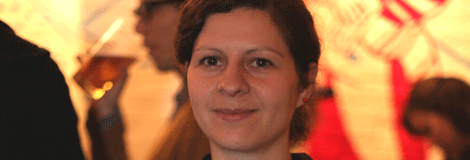Artist Katja Spitzer and the letter Q
The letter Q has a special place within British culture. It is the codename for the man responsible for some of James Bond’s best gadgets. It features in some of our cherished institutions such as QI, Question Time and the QE2 bridge. And according to that most irritatingly true of clichés, there’s also nothing the British love more than a Q.
Now the letter Q has its own exhibition, dedicated to everything weird and wonderful that falls within that slim section of the dictionary. It is the work of illustrator Katja Spitzer. It takes her from extinct African animals to Quentin Tarrantino to obscure 18th-century dances. The London Word caught up with her ahead of her exhibition at The Book Club in Shoreditch.
When did you first start illustrating?
‘Ten years ago. I always loved drawing and as it progressed I developed my personal style during my studies.’
What was it like growing up in East Germany?
‘I was eleven when the wall came down. I spent 11 years in the GDR [German Democratic Republic] and grew up in a small town two hours away from Berlin. I have a younger sister and after school we joined a biology group and a vaulting group. We spent our holidays in a place which was offered through my parents’ jobs.
‘We had to wait some years to get a telephone or buy a car. We couldn’t visit our relatives in the western part of Germany, we couldn’t even call them. They visited us a few times and that was always a pleasure for us children, because of the sweets they gave us. Since we weren’t allowed to leave the country there were many possibilities to spend free time. But I remember the absence of colour everywhere.
‘Houses and streets in the GDR were grey and dull. The architecture was ugly and not individual in any way. There were no decorations, coloured advertising signs or coloured logos or posters. Even the clothes and wares in the shops were grey. The most of the fruit and vegetables you could buy there were canned only.
‘After the “Wende” [the change from socialism to market economy and capitalism] was introduced in 1989 it was such a relief for us. Finally we could leave the country and visit our relatives in the West. I visited a city in the West the first time in 1989 and it was such a shock for my eyes, but my sister and I loved it. The years before the Wende we pictured the West as a kind of wonderland. And so it was.’
How did you evolve your particular style?
‘I didn’t push for it, it comes naturally.’
What is distinctive about exhibiting in London compared to other cities?
‘Every city has got its own charm, but somehow the atmosphere in London made me feel more creative and more alive. I was very excited when Nobrow asked me to do the show, I didn’t know much about the space, but I had an immediate good feelings about it. I feel really lucky to have this opportunity to work both with Nobrow and The Book Club.’
How does the art scene in Berlin compared to the one in London?
‘It seems very young and vivid, not too far away from Berlin, but even more intense and fast moving.’
The exhibition is centred around the letter Q as it is a rarely used letter. Why did you choose it over other less common letters such as X or Z?
‘There are so many interesting words starting with the letter Q, like Quagga, Quattrocento and Qilin which are the same in both English and German, which I found really fascinating to draw. For instance, Quagga is a sort of zebra which went extinct in the 19th century as a consequence of game hunting. I didn’t know about the Quagga before. Or about the Qilin. Qilin is a Chinese chimerical creature which is also known as the Chinese unicorn.
‘Some other terms I knew before like Mary Quant the founder of the mini skirt or Quattrocento as an era of the renaissance. I wanted to make a nice collection of terms and create interesting pictures and stories.’
There is a certain dry sense of humour within your pieces. Do you think this will resonate much more with English viewers?
‘I really hope it will. I think my sense of humour will be the thing that helps the English viewers relate to the illustrations.’
What are your next projects?
‘This show had opened lots of doors for me. I already got invited to join a group exhibition with some great illustration artists in January at The Book Club. I have some future projects with Nobrow and I am about to complete a non-fiction illustration book for children in Germany.’
Quodlibet is on until 27 November at:
The Book Club
100-106 Leonard Street
Shoreditch
EC2A 4RH
Tel: 020 7684 8618
Image by Andy Hague






